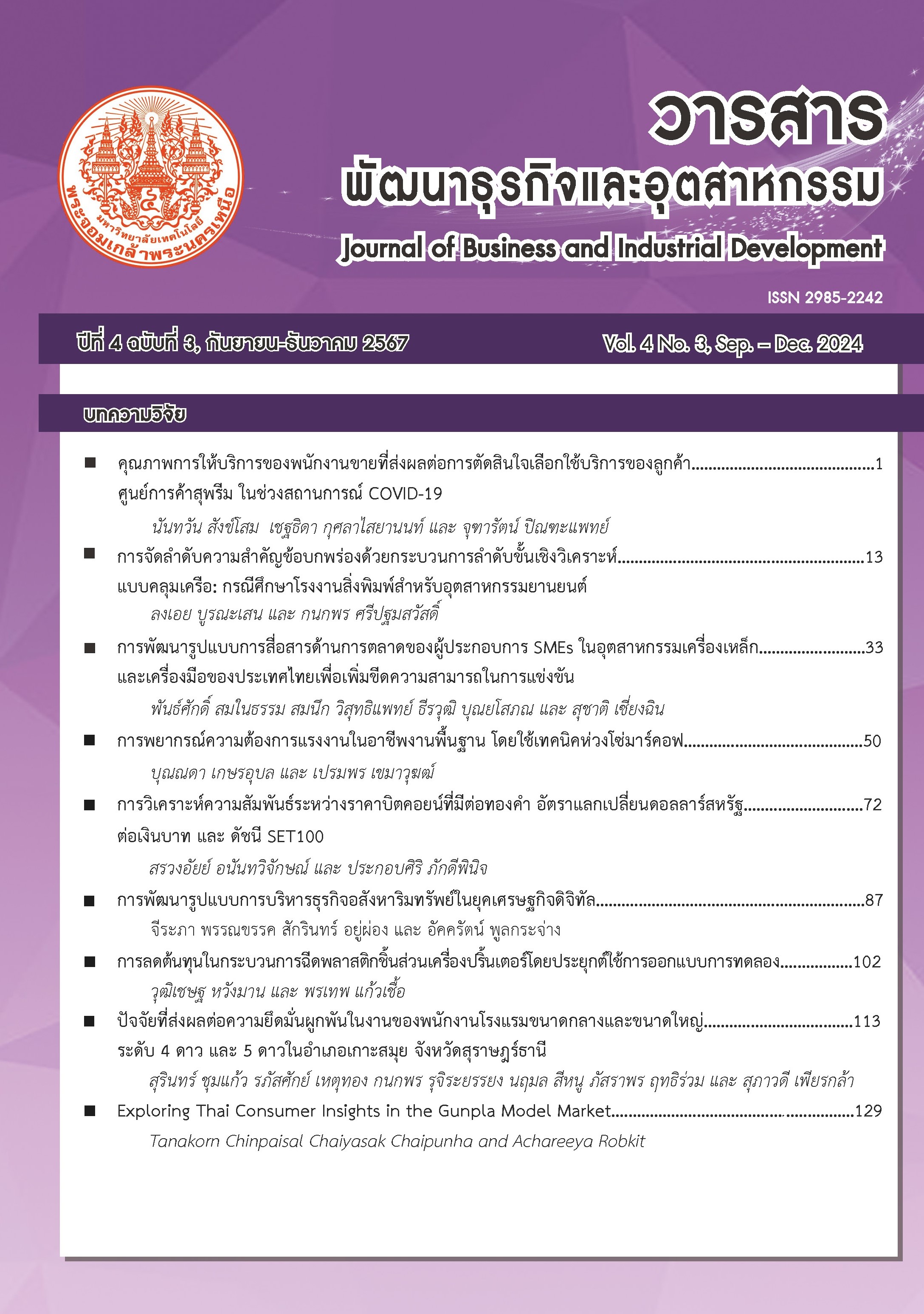Forecasting Labor Demand in Elementary Occupations Using the Markov Chain Model
Keywords:
Forecasting, Markov Chain Model, Class Interval, Mean Absolute Percentage ErrorAbstract
This research studies the forecasting pattern using the Markov chain model for data on labor demand in elementary occupations in the Thailand labor market. It analyzes the data's characteristics by utilizing past labor demand in elementary occupations to construct the most suitable forecasting model. The data gathered from the Department of Employment, Ministry of Labor, regarding the labor demand and registered applicants categorized by occupation in Thailand from January 2016 to December 2023, a total of 96 months. It reveals that labor demand in elementary occupations experiences the highest labor shortage, accounting for 43.08% of the total shortages observed. Therefore, the researchers proposed creating a model to forecast the labor demand in elementary occupations in Thailand's labor market to efficiently plan the labor aligned with market demand in the future. Labor shortage data has rapidly changed since 2020 due to the COVID-19 pandemic, causing labor shortages across industries. The researchers divided the data into two sets for comparison. Set 1 compost of 96 months and set 2 compost of 48 months. Each dataset includes 5 Markov chain models for forecasting labor demand in 3 periods (from 2021 to 2023) and sets the class interval as 10, 15, 20, 25, and 30. Upon examination of the 2 data sets, it was found that Data Set 1 has a higher mean absolute percentage error than Data Set 2. Due to the high volatility of data set 1, forecasts for this data set have a high mean absolute percentage error. It differs from data set 2, which is less volatile; forecasts for this dataset have a low mean absolute percentage error. Additionally, the different level of class interval affects the absolute percentage error, with the increasing class interval found to result in higher accuracy. The optimal granularity for both datasets was 30 intervals. Set 1 has a mean absolute percentage error of 17.84%, while Set 2 has a mean absolute percentage error of 9.44%.
References
Unseri, K. (2554). ASEAN Economic Community. Institute of Damrong Rajanupab Documents, (15th ed.). http://www.stabundamrong.go.th/web/book54.html. (in Thai)
Sumanat, K. (2017). Stochastic Petri Net to Markov Chain Conversion [Unpublished master's thesis]. Chulalongkorn University. (in Thai)
Bureau of Data Management and Statistics, Strategic and Planning Division, Department of Employment. (2023). Labor Statistics 2023. Department of Employment, Ministry of Labor, (8th ed.).https://lib.doe.go.th. (in Thai)
Labor Statistics Group, Social Statistics Bureau, National Statistical Office. (2022). Impact of COVID-19 Pandemic on Employment Survey. (6th ed.). https://www.nso.go.th/sites/Full_report_covid (in Thai)
Kasemsub, W. (2021). Is Thailand Ready for an Aged Society? Office of Organizational Communication, General Administration Division, Mahidol University. https://op.mahidol.ac.th/ga/posttoday-22-2/#. (in Thai)
Phumkesorn, P. (2019). Forecasting the Price of RSS3 Rubber Using Markov Chain Models. Journal of King Mongkut's University of Technology North Bangkok, 29(1), 34-45. https://DOI:10.14416/j.kmutnb.2018.11.008. (in Thai)
Wichachai, P. (1983). Forecasting the Labor Demand in Thailand’s Automobile Manufacturing Industry [Unpublished master's thesis]. Chulalongkorn University. (in Thai)
Riansut, W. (2016). Forecasting Unemployment Rate in Thailand. Journal of Science and Technology, Naresuan University, 24(1), 102–114. https://www.thaiscience.info/Journals/Article/NUST/10981784.pdf (in Thai)
Usahakit, V. (2021). Forecasting Unemployment Rates in Thailand. In A. Sawatsathithi (Ed.), National Research Conference on Science and Technology (NCST) 2021 (pp. 324–329). Graduate School, Chandrakeasem Rajabhat University. https://sci.chandra.ac.th/ncst2021/jdownloads/99/3/9.P-63.pdf (in Thai)
Jaijit, S. (2015). Prioritizing Medicines with Multi-Criteria Decision Models Using Markov Chains: A Case Study of a Pharmaceutical Distributor in Thailand. Journal of Engineering, Siam University, 15(2), 13–23. (in Thai)
Chaiaphorn, N. (1998). Markov Chain Processes and Applications [Unpublished master's thesis]. Chiang Mai University. https://ph01.tci-thaijo.org/index.php/IT_Journal/article/view/74103/59826. (in Thai)
Vithayaprakorn, A. (2017). Analyzing Gold Price with Markov Chain Methods. Journal of Industrial Technology, King Mongkut's University of Technology North Bangkok, 13(3), 48–58. (in Thai)
Beaumont, C., et al. (1978). Forecasting Methods and Applications. (2nd ed.) America: Carolyn Geiger.
Eroglu, M., & Servi, T. (2012). A New Approach for Determining Number of Clusters. Pakistan Journal of Statistics, 28(1), 141–158. https://www.researchgate.net/publication/263747242
Lian, Z., et al. (2019). A perishable inventory model with Markovian renewal demands. International Journal of Production Economics, 121(1), 176–182.
Vidyadhar, G. Kulkarni. (2009). Modeling and Analysis of Stochastic Systems. (2nd ed.) CRC Press Taylor&Francis group.
Voskoglou MGr. (2016). Applications of finite Markov chain models to management. American Journal of Computational and Applied Mathematics, 6(1), 7–13.
Downloads
Published
How to Cite
Issue
Section
License
Copyright (c) 2024 Journal of Business and Industrial Development

This work is licensed under a Creative Commons Attribution-NonCommercial-NoDerivatives 4.0 International License.





